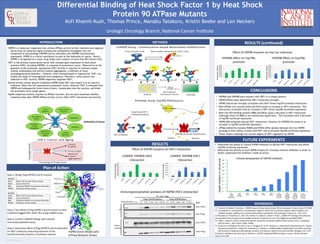More Related Content
Similar to kofiCRIposter2013
Similar to kofiCRIposter2013 (20)
kofiCRIposter2013
- 1. RESEARCH POSTER PRESENTATION DESIGN © 2011
www.PosterPresentations.com
INTRODUCTION
Plan
of
Ac<on
RESULTS
CONCLUSIONS
REFERENCES
Differential Binding of Heat Shock Factor 1 by Heat Shock
Protein 90 ATPase Mutants
Urologic
Oncology
Branch,
Na.onal
Cancer
Ins.tute
Kofi Khamit-Kush, Thomas Prince, Manabu Tatokoro, Kristin Beebe and Len Neckers
METHODS
• HSP90A and HSP90B each interact with HSF1 in a unique pattern.
• HSP90 ATPase state determines HSF1 interaction strength.
• HSP90 interaction strength correlates with HSF1-driven hsp70-luciferase interaction
• Both ATPase null mutants E42A and E47A cause an increase in HSF1 interaction. This
interaction correlates with an increase in HSF1 driven hsp70b-luciferase expression.
• Both non-ATP-binding mutants D88A and D93A cause a decrease in HSF1 interaction
(although effect of D88A is not statistically significant). This correlates with a decrease
in hsp70b-luciferase expression.
• HSP90 b8A mutations disrupt HSF1 interaction, however for HSP90A this leads to an
increase in hsp70b-luciferase expression.
• ATPase-defective mutants R400A and R392A differ greatly between the two HSP90
paralogs in their ability to both bind HSF1 and to promote hsp70b-luciferase expression.
• These results challenge the current dogma of HSF1 regulation by HSP90.
Clinical development of HSP90 inhibitors
Hsp90inhibitorsinclinicaltrial
1994
PNAS
ID Target
1999
17-AAG
2004
17-DMAG
2005
IPI-504
2006
BIIB021
2007
SNX-5422
AUY922
KW-2478
2008
IPI-493
BIIB028
STA-9090
XL888
2009
AT13387
HSP990
MPC-3100
ABI-01
2010
Debio 0932
PU-H71
DS-2248
0
6
8
12
18
16
2
4
10
14
1970
Deboer
J. Antibiot.
Geldanamycin
RESULTS
(con<nued)
HSP90
Dimer
Model
with
ATPase
Mutants
Shown
Immunoprecipita.on
analysis
of
HSP90-‐HSF1
interac.on
HSP90A
E47A
Binds
ATP
but
null
ATPase
ac.vity
D93A
Cannot
bind
ATP
b8A
Defec.ve
HSP90
intra-‐domain
interac.on
R400A
Defec.ve
ATPase
ac.vity
HSP90B
E42A
Binds
ATP
but
null
ATPase
ac.vity
D88A
Cannot
bind
ATP
b8A
Defec.ve
HSP90
intra-‐domain
interac.on
R392A
Defec.ve
ATPase
ac.vity
HSP90 is a molecular chaperone that utilizes ATPase activity to fold, maintain and regulate
the activity of numerous signal transduction components throughout the cell.
Comprised of two paralogs (HSP90A (stress inducible) and HSP90B (constitutively
expressed), HSP90 is a critical contributor to each of the hallmarks of cancer. Hence,
HSP90 is recognized as a major drug target and a subject of more than 80 clinical trials.
HSF1 is the primary transcription factor that initiates gene expression of heat shock
proteins (HSP), including HSP90A, in response to proteotoxic stress. Referred to as the
guardian of the proteome, appropriate HSF1 activity is required to maintain proper
cellular proteostasis and prevent protein aggregation, a hallmark of many
neurodegenerative disorders. However, when overexpressed or hyperactive, HSF1 can
enable the onset of tumorigenesis and malignancy. Therefore, many cancers are
addicted to HSF1 activity. HSP90 negatively regulates HSF1.
During normal cellular growth conditions HSP90 binds HSF1 and retains it as an inactive
monomer. When the cell experiences proteotoxic stress, however, HSF1 is released from
HSP90 and subsequently forms homo-trimers, translocates into the nucleus, and binds
the promoters of its target genes.
Hsp90 chaperone activity requires its ATPase function, and we have examined whether
mutations that alter HSP90 ATPase activity in turn affect HSF1 interaction and activity.
Step
1:
Design
Flag-‐HSP90
A
and
B
mutants.
Step
2:
Test
ability
of
Flag-‐HSP90
A
and
B
mutants
to
bind
Luciferase-‐tagged
HSF1
(HSF1-‐NL)
using
LUMIER
assay.
Step
3:
Confirm
LUMIER
findings
with
classical
immunoprecipita.on
assay.
Step
4:
Determine
effect
of
Flag-‐HSP90
A
and
B
interac.on
on
HSF1
ac.vity
by
measuring
induc.on
of
the
hsp70b
promoter
fused
to
a
luciferase
reporter.
FUTURE
EXPERIMENTS
• Determine the ability of clinical HSP90 inhibitors to disrupt HSF1 interaction and affect
hsp70b-luciferase expression.
• Determine the affinity of each HSP90 mutant for clinically relevant inhibitors in order to
better understand the inhibitors’ mode of action.
Evade
Immune
Response
Limitless
Replica.on
Angiogenesis
Metastasis
Insensi.ve
to
An.-‐growth
Signals
Evade
Apoptosis
Self-‐sufficient
Growth
Reprogram
Energy
Metabolism
HSP90
Hallmarks
of
Cancer
1) Tsutsumi
S,
Beebe
K,
Neckers
L.
(2009)
Impact
of
heat-‐shock
protein
90
on
metastasis.
Future
Oncol.
679-‐688.
2) Cunningham
C,
Southworth
D,
Krukenberg
K,
Agard
D.
(2012)
The
conserved
arginine
380
of
Hsp90
is
not
cataly.c
residue,
stabilizes
the
closed
conforma.on
required
for
ATP
hydrolysis.
Protein
Sci.
1161-‐1171.
3)
Panaretou
B,
Prodromou
C,
Roe
S.M,
O'Brien
R,
Ladbury
J,
Piper
P,
Pearl
L.
(1998)
ATP
binding
and
hydrolysis
are
essen.al
to
the
func.on
of
the
Hsp90
molecular
chaperone
in
vivo.
The
EMBO
Journal
4829-‐4836.
4) Pullen
L,
Bolon
D.
(2011)
Enforced
N-‐domain
proximity
s.mulates
Hsp90
ATPase
ac.vity
and
is
compa.ble
with
func.on.
J.
Biol.
Chem
11091-‐11098.
5) Tsutsumi
S,
Mollapour
M,
Graf
C,
Lee
C,
Scroggins
B,
Xu
W,
Haslerova
L,
Hessling
M,
Konstan.nova
A,
Trepel
J,
Panaretou
B,
Buchner
J,
Mayer
M,
Prodromou
C,
Neckers
L.
(2009)
Hsp90
charged-‐linker
trunca.on
reverses
the
func.on
of
weakened
hydrophobic
contacts
in
N
domain.
Nature
Structural
and
Mol.
Biology
1141-‐1147.
6)
Trepel
J,
Mollapour
M,
Giaccone
G,
Neckers
L.
(2010)
Targe.ng
HSP90
complex
in
cancer.
Nature
Review:
Cancer
537-‐549.
